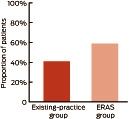How can we best protect patients while making progress?
The pace of development in new surgical procedures and technologies continues to accelerate, driven in part by manufacturers, surgeons and community expectations. Despite regulatory bodies such as the Therapeutic Goods Administration (TGA), new devices can enter the market with little or no evidence of their effectiveness, and even their safety can be poorly evaluated. The withdrawal of the DePuy Orthopaedics articular surface replacement hip prosthesis illustrates the difficulty in anticipating the unintended problems with a joint prosthesis that superficially appeared to be little different from hundreds of others already available on the market.1
Innovation is not well regulated
While the TGA attempts to assess devices, the evidence base necessary for determining their durability in human use is rarely available or is inadequate. The introduction of new procedures is even less regulated. If a completely new procedure is developed and a Medicare item number is sought, then the Medical Services Advisory Committee2 would usually assess its merits; however, this is not required in the public health system.
Of greater concern is the ability to use existing Medicare descriptors to cover new procedures. This occurred with the introduction of laparoscopic cholecystectomy in 1991 and enabled an untested new procedure to be introduced without approval, oversight or training. The subsequent outcry prompted the federal government, in partnership with the Royal Australasian College of Surgeons, to establish the Australian Safety and Efficacy Register of New Interventional Procedures – Surgical (ASERNIP-S) to evaluate the evidence for new devices or procedures and to report to surgeons, patients, government and hospitals on their evidence base and training implications.3
In 2006, ASERNIP-S evaluated three endoscopic antireflux procedures and found that evidence to support their use was lacking. Despite this, they were taken up by enthusiastic practitioners — surgeons as well as gastroenterologists. They have now completely disappeared from practice. Few reports of their failure have appeared, yet thousands of patients were subjected to these now-abandoned interventions.4
In recent years, hospitals have started to play a greater role in credentialling surgeons for procedures, and committees often exist to evaluate new procedures that are introduced into a health care facility. While an admirable principle, the practice is often flawed. New surgical approaches using existing technologies, such as laparoscopic hernia repair or laparoscopic liver resection, can be introduced into operating theatres at the discretion of the surgeon. Unless the ethical imperative to notify the institution is clear and policed, this practice may continue.
The introduction of robotic-assisted surgery for prostate operations has been widely debated.5 However, the same discussion and rigour has not been applied to robotic assistance in ear, nose and throat, gynaecological and colorectal surgery. Indeed, it is even now being used in thyroid surgery with limited evidence.6
The IDEAL recommendations
The problem of the introduction of new surgical technology and procedures has been addressed by the IDEAL recommendations.7 This concept does not view surgical development as different from non-surgical advances. The recommendations involve suggestions for the five stages of evaluating new surgical procedures — innovation, development, exploration, assessment and long-term (or surveillance) stages. Innovation will apply to interventions such as stem cell-based tracheal transplantation for tracheal stenosis.8 Exploration may apply to single-incision laparoscopy, with long-term studies being directed at procedures such as surgery for morbid obesity.8
IDEAL encourages full reporting and staged introduction of new surgical technologies so that the disasters of the past can be avoided and new lessons can be learnt quickly and disseminated. Prospective databases and registries for new procedures and techniques will allow monitoring of early as well as late and rare outcomes.
Patients are vital to progress
It is difficult for patients to provide full and informed consent for a new or innovative procedure, as results and outcomes are lacking. Preferably, the effectiveness of such uncertain new interventions would be established through ethically constructed and approved trials from which, hopefully, outcome data would be reported to the wider medical community. The participation of patients who have undergone a full and informed consent process is vital to making progress with surgical improvements and breakthroughs.
However, individual practitioners’ enthusiasm for or belief in a new operation should not expose patients to oversold, poorly evaluated interventions. Surgical randomised controlled trials are difficult to perform, but they are possible. There are very few examples of operations that cannot be carefully evaluated following the IDEAL recommendations.9 Usually, there are alternative established approaches that provide other avenues for patients who are unwilling to be included in research studies.
Surgeons have a responsibility to innovate, stay up-to-date and retrain, primarily for the benefit of their patients. Guidelines, processes and regulations exist and should be embraced. Do we really know the place of innovative technologies and practices that are already in use — for example, duodenal sleeve technology,10 peritonectomy,11 robotic thyroid surgery5 or mitral clip technology?12 If not, how carefully and ethically are they being introduced into mainstream practice?

 more_vert
more_vert